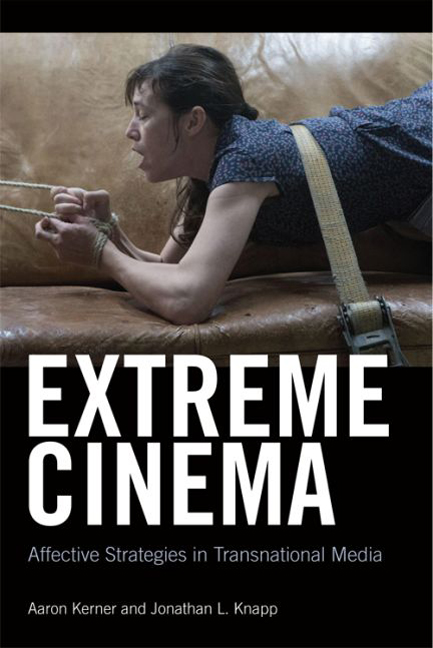Book contents
- Frontmatter
- Contents
- List of Figures
- Acknowledgments
- 1 Extreme Cinema: Revisiting Body Genres
- 2 Hearing: With a Touch of Sound—The Affective Charge of Audio Design
- 3 Pain: Exploring Bodies, Technology, and Endurance
- 4 Laughter: Belly-aching Laughter
- 5 Arousal: Graphic Encounters
- 6 Crying: Dreadful Melodramas—Family Dramas and Home Invasions
- 7 The End of Extreme Cinema?
- Bibliography
- Filmography
- Index
7 - The End of Extreme Cinema?
- Frontmatter
- Contents
- List of Figures
- Acknowledgments
- 1 Extreme Cinema: Revisiting Body Genres
- 2 Hearing: With a Touch of Sound—The Affective Charge of Audio Design
- 3 Pain: Exploring Bodies, Technology, and Endurance
- 4 Laughter: Belly-aching Laughter
- 5 Arousal: Graphic Encounters
- 6 Crying: Dreadful Melodramas—Family Dramas and Home Invasions
- 7 The End of Extreme Cinema?
- Bibliography
- Filmography
- Index
Summary
A void that is not nothing but indicates, within its discourse, a challenge to symbolization. Whether we call it an affect or link it with infantile semiotization—for which pre-signifying articulations are merely equations rather than symbolic equivalents for objects, we must point to a necessity within analysis. This necessity, emphasized by that type of structure, consists in not reducing analytic attention to language to that of philosophical idealism and, in its wake, to linguistics; the point is, quite to the contrary, to posit a heterogeneity of signifiance. It stands to reason that one can say nothing of such (effective or semiotic) heterogeneity without making it homologous with the linguistic signifier.
INTRODUCTION: NOT A STYLE, BUT STYLIZED CINEMA
As we have indicated in the present volume, one of the most significant tropes of extreme cinema is its potential to elicit affect. And this enterprise is potentially frustrating, for in the very instant that we subject affecting moments in the cinema to analytic discourse we can witness them slip away—in effect trying to render the non-object (semiotic) in the realm of discourse (Symbolic). And for better or for worse, submitting the affective referent to the analytic gaze wields the potential to neutralize that which spawns sensation. Furthermore, the affective experience is hardly universal, and although we have perhaps over-“idealized” the affective as pan-cultural in certain instances, it is clear that it is subject to cultural, historical, and personal mediation. While we appreciate the dangers inherent in such a project, we have nonetheless made preliminary gestures toward identifying general tendencies in extreme cinema.
Inadvertently, we admit, we might have also “fed the beast.” Jinhee Choi and Mitsuyo Wada-Marciano correctly raise concerns about the term “extreme,” particularly as it has been applied to Asian films. Distributors in fact, have used “extreme,” as a marketing device—promising to deliver spectacles of gore and/or salacious sexual content (almost invariably tinged with violence). “Asia Extreme” is a “DVD label launched by London-based distributor Metro Tartan,” and has been used as a convenient way to package films from radically different cultural contexts. “The strategic designation ‘Asia Extreme’ has undoubtedly created a regional affiliation among these [Asian] directors’ films, but the category itself is purposefully flexible in order to include a range of Asian cinema that seems exportable.”
- Type
- Chapter
- Information
- Extreme CinemaAffective Strategies in Transnational Media, pp. 156 - 161Publisher: Edinburgh University PressPrint publication year: 2016



